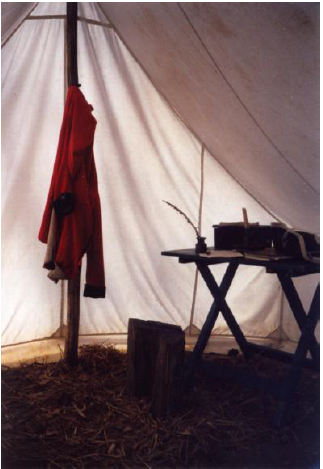The Revolutionary War - Overview
Stafford’s American Revolution cohort consisted of 66 men in the Continental Army and 489 whose approved Revolutionary War Public Service Claims are on file in the Virginia State Library. Perhaps as many as 1,000 Staffordians were involved in the Revolution at one time or another.
Through April 2000, due to research by Mike and Marty Lyman, evidence was found of Stafford burials of 18 “Revolutionary Soldiers and Patriots” (who served or supported independence respectively): David Briggs; Travers Daniel, Jr.; Frances Daniel; John DeBaptist; John Hedges; Gerald Hooe; Elias Hore; James Hunter, Sr.; Arthur Morson; George Norman; Thomas Norman; William Phillips; Wily Roy; Joseph Sanford; William Stark; Hawkins Stone; John Wallace; and William Waller, Sr.
Representative of Colonial- and Revolutionary-era Staffordians were the Wallaces of “Ellerslie” (located on the south side of Virginia 652 and 654). Their story begins with indentured servitude of Scotsman Michael Wallace to Dr. Gustavus Brown of Maryland. Michael studied medicine with Dr. Brown during his indenture, but interrupted his studies to elope with Brown’s daughter. Brown didn’t press the issue, and the Wallaces settled in Falmouth, where he established a medical practice covering Stafford and surrounding counties. In 1748 he purchased Waugh tract land and built “Ellerslie,“ named for an ancestral Scottish estate. The Wallaces rebuilt their house in 1754 after it was partially burned (the second dwelling apparently used part of the original as some burnt timbers are evident). The story, detailed by local historian Jerriylnn Eby MacGregor, continues:
Ellerslie’s most famous resident was Dr. Michael Wallace’s son, Lt.Col. Gustavus Brown Wallace (1751-1802). After attending school in Fredericksburg, he began studying law in 1774. His studies were interrupted by the death of his aunt in Scotland necessitating a trip abroad in 1775. That same year he returned to Virginia and enlisted in the Continental Army as a captain. In the fall of 1777 he was promoted to major and served under Colonel Daniel Morgan. Major Wallace spent the terrible winter with his men at Valley Forge. He was transferred from the 3rd to the 25th Virginia Regiment and, finally, to the 2nd Virginia Regiment. During the late 1770s he was captured by the British at Charleston. At the request of Governor Thomas Nelson, Lord Cornwallis released him on parole so that he could return to Virginia. There he was to make arrangements for officers of the Virginia Line to pay the debts they incurred at Charleston. After the Revolution, Wallace was given 7,000 acres of land in Virginia for his services during the war. He was also given an additional 960 acres for special services.
In 1802 Colonel Wallace made a business trip to Scotland. On the return voyage he contracted typhus. Reaching Potomac Creek, the ship’s captain put Wallace off the boat, fortunately on property belonging to his cousin, Mrs. Travers Daniel of “Crow’s Nest.” Servants found Colonel Wallace and notified Mrs. Daniel. She sent a cart for him and had him taken to a Fredericksburg doctor. Several days later, he died and was buried at the Masonic Cemetery in Fredericksburg. He died unmarried.

The Revolution brought substantial changes in Stafford’s whites’ and blacks’ lives. It is unknown whether black Staffordians were among the army combatants in the Revolution; however, given the numbers of serving white Staffordians and the county’s north-south communications position, it is likely that some served. Black soldiers fought in both the Continental Army and in British service on promise of freedom for service. By 1779 an estimated 15 percent of the Continental Army and an unknown portion of the Navy — such as John DeBaptist were African-Americans. This participation is credited with convincing some Northerners that slavery was a poor policy.

